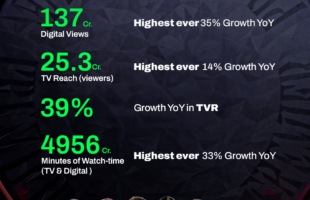Watching how fast new 3D TV sets are being sold at Singapore electronic stores, you could be forgiven for thinking that consumers here are rushing home to watch new 3D TV programmes on their brand spanking new screens.
But while falling prices of sets are pushing sales up for electronics makers such as Samsung, LG and Sony, the software, in the form of 3D TV content, has yet to show substantial growth in Singapore.
Since the fi rst such programmes started appearing late last year, there have been several ad hoc screenings – mostly as teasers of what is technically possible in the future – rather than a major 3D rollout from any one broadcaster or channel.
Of the three main broadcasters here, SingTel seems the most confi dent about the future of 3D TV content.
Recently, it started showing selected live Barclays Premier League matches in 3D, beginning with a blockbuster clash between Manchester United and Arsenal in May.
Mr Goh Seow Eng, who looks after digital home services at SingTel, promised more content on the way. Next season, one Premier League match each month will be on 3D, he told TV ASIA Plus.
Several 3D documentaries also screened in July, adding to the list of 3D movies, such as Despicable Me, Resident Evil: Afterlife and The Green Hornet, that have already screened this year.
He noted: “We expect the take-up to increase due to falling 3D TV prices, an increase in worldwide shipments of 3D TVs, and more content being produced in 3D and in a wider variety of genres, not just movies.”
Yet, SingTel’s counterparts do not seem to share the same enthusiasm as the IPTV (Internet Protocol TV) operator – at least for now.
StarHub, for example, offered customers a glimpse of 3D back in 2008 by partnering with the Disney Channel, but has since not added any 3D programmes to its lineup despite the content becoming more common.
Spokesperson Huang Shu-Yin did say that the cable operator “was in talks” with content providers for both original 3D and converted 3D content, but she was coy with the details as well.
Free-to-air rival MediaCorp also appears to be only testing the water. It has been running trials of 3D TV since November 2010, but has not gone far beyond broadcasting a concert, a national day parade and a locally-made documentary.
Mr Wee Way Kiat, its executive vice president for strategy and technology, said the promise of 3D TV is clear, in that it offers a different viewing experience, which tech-savvy Singaporeans will appreciate. “But just like other technologies,
3D TV is relatively nascent and 3D TV standards are still evolving,” he noted, adding that it would be another two to three years before the technology takes off in a big way here.
He blamed the problem partly on a lack of standards – some 3D technologies require users to put on active 3D glasses while others process ‘the experience’ inside the TV. Then, there is the shortage of 3D content, which will take time to catch up with what’s capable on new 3D TVs now, he said.
Plus, even for technology-mad Singapore, he noted that “non-3D HD TVs only started to become widely available and at more affordable prices in the last 12 months, so it will take a while for these TVs to be replaced with 3D TVs.”
Indeed, many market watchers have compared the current slow takeup in 3D TV to another slow-moving technology – HDTV. High-Def is fi nally now available on a number of popular channels from SingTel, StarHub and MediaCorp.
Premier League matches are shown in HD, as are programmes on StarWorld, Food Network Asia, AETN All Asia Networks and HBO. MediaCorp has an HD version of Channel 5, while Nat Geo has a separate channel playing HD content. In May, StarHub added new music channel MTVN HD to its lineup and HD versions of Universal Channel and SyFy also came onboard.
When it comes to perspective, the difference is that 3D requires a bigger change in consumer habits than the move from SD to HD, where benefi ts are literally right in front of viewers.
Last year, Singapore’s three broadcasters all took part in a S$5million 3DTV trial funded by Singapore’s Media Development Authority. The result, according to the authorities, is that all three broadcasters are now ready to deliver 3D to homes here. But their problems are likely to be global, and not easily solved through a generous state grant.
Indeed, throughout Asia, the situation is not much different. According to a report by research fi rm Ovum released in May, broadcasters are said to rate the production of 3D content and channels as the lowest in their investment priorities. Reason: the high cost of infrastructure and personnel.
Ovum analyst Tim Renowden, the report’s author, wrote: “This ambivalence towards investment in 3D content production and creation of 3D channels leaves a big hole in the availability of 3D content, and tells us that the lack of 3D programming we have seen during 2010 is unlikely to improve in 2011.”
So, what can broadcasters do to turn things around without splashing loads of cash into a nascent technology?
According to MediaCorp’s Mr Wee, live programmes with “fi xed reference positions” such as stadium sports – like football – and concerts are typically ideal for 3D TV production and delivery.
Then there are animation and programmes with lots of special effects, he noted. These are well suited for 3D technology because such effects can be created without the need for cameras and it is much easier to synchronize the images for 3D effects, he explained.
Some in the industry, such as Discovery Networks, are certain that 3D is not a fad, but similar in the move from silent movies to “talkies”, from black-and-white to colour and from SD to HD.
In February, Discovery launched a 24/7 3D channel called 3Net in the United States. It expects 3Net to eventually have the largest library of original and exclusive 3D content anywhere.
Said Tom Keaveny, executive vicepresident and managing director of Discovery Networks Asia-Pacifi c, “There’s a lot of buzz around the technology but in Asia-Pacifi c, with the HD market still in its infancy, I think it will take a few more years before 3D has a mass audience.”
Though the region is diverse, he said he is confi dent that is able to adopt leapfrogging technologies. “We may well see this in the 3D space in certain markets like Japan, Korea and Australia, for example.”
At least a handful of production houses in Singapore are embarking on 3D projects, believing in its mass adoption in the future.
One of them, Beach House Pictures, has delivered 10 hours of 3D content this year to 3Net in the US and has a couple of other 3D projects in the pipeline which will be shot in the region.
Managing director Jocelyn Little is bullish about 3D. “Once commercial glassless 3D televisions are available in the market at a reasonable cost, the uptake will increase signifi cantly,” she predicted.
But transmission cost of broadcasting such content is still a major disincentive limiting operators from jumping on the 3D bandwagon said Deepakjit Singh Chatrath, MD of Encompass Digital Media, Asia, in Singapore. “In Asia, most of the TV channels are still distributed over Satellite. The bandwidth requirement for 3D channels is more than 8 to 10 times the requirement for a typical SD channel.
“In my opinion, Pay TV operators will not be able to charge the consumer 3 to 4 times what they are charging today to run a 3D channel.”
Chatrath added that only when encoding technologies improve and 3D channels can transmit within a smaller bandwidth, will take-up of 3D improve.
For now, no one knows for sure what factors will make 3DTV a must have upgrade in consumers’ homes. Said Ovum’s Mr Renowden, “Several broadcasters and pay-TV operators, such as Fox Sports and the Seven Network in Australia, have presented 3D programming on an ad hoc basis. In Japan, NTT Plala’s IPTV service, Hikari TV, includes a 3D on-demand pay-per-view portal.”
“Given the lack of enthusiasm for investing in 3D content production and delivery expressed by broadcasters, this situation is unlikely to change rapidly,” he added, predicting that game consoles like the already ubiquitous Sony Playstation 3 would be the main driver of 3D adoption.
In other words, all those happy TV buyers over the weekend should at least have something – 3D-enabled games and the handful of 3D movies on the game console – to tide over the boredom while they wait for 3DTV channels to come online in the next few years.








